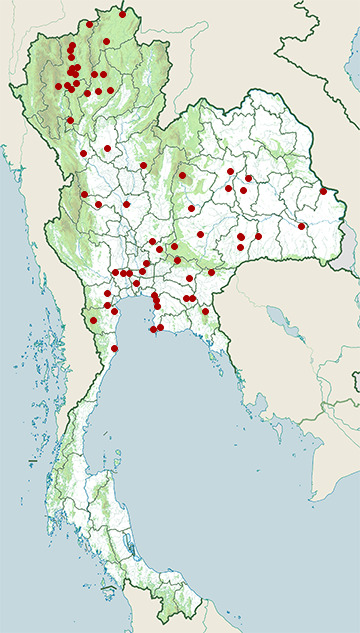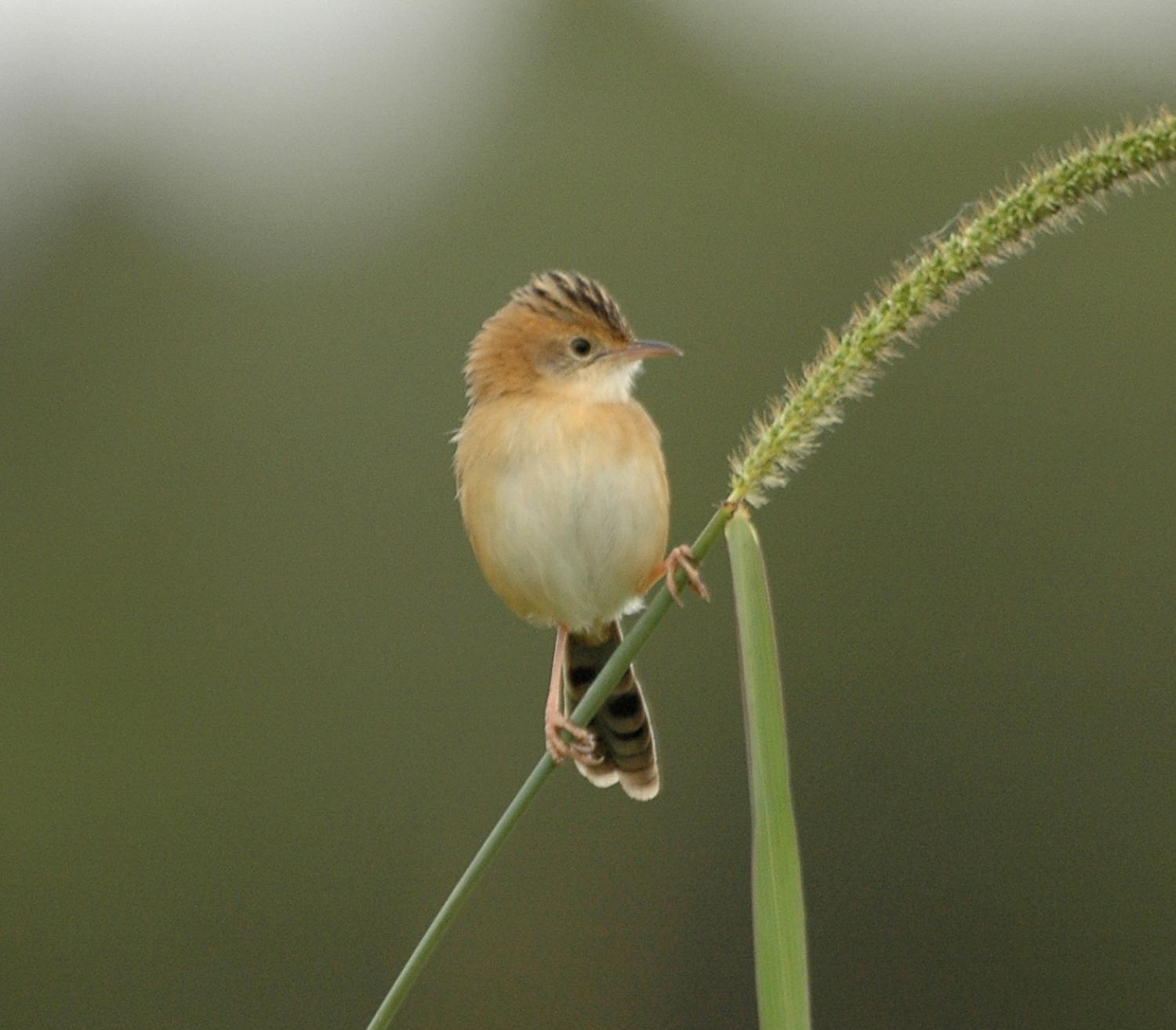Species of Thailand
Bright-capped cisticola
Cisticola exilis
Nicholas Aylward Vigors & Thomas Horsfield, 1827
In Thai: นกยอดข้าวหางแพนหัวแดง
The golden-headed cisticola (Cisticola exilis), also known as the bright-capped cisticola, is a species of warbler in the family Cisticolidae, found in Australia and 13 Asian countries. Growing to 9 – 11.5 cm long, it is usually brown and cream in colour, but has a different appearance during the mating season, with a gold-coloured body and a much shorter tail. It is an omnivore and frequently makes a variety of vocalizations. Known as the "finest tailor of all birds", it constructs nests out of plants and spider threads. It mates in the rainy season. It has a very large range and population, which is thought to be increasing.
Taxonomy
The golden-headed cisticola was described by the naturalists Nicholas Vigors and Thomas Horsfield in 1827 and given the binomial name Malurus exilis. The specific epithet exilis is the Latin word for "small", "slender" or "thin". It is now placed in the genus Cisticola, which was erected by the German naturalist Johann Jakob Kaup in 1829. This species has been known by several English names in addition to the golden-headed cisticola, including bright-capped cisticola, bright-headed cisticola, bright-crowned cisticola, gold-capped cisticola, yellow-headed cisticola, exile warbler and fan-tail warbler. It has been called a tailorbird, but it is not closely related to Orthotomus, a genus containing 13 species known as tailorbirds.
Twelve subspecies are recognized:
- C. e. tytleri Jerdon, 1863 – south Nepal and northeast India to north Myanmar and southwest China
- C. e. erythrocephalus Blyth, 1851 – peninsular India
- C. e. equicaudatus Baker, E.C.S., 1924 – east Myanmar, Thailand and Indochina
- C. e. courtoisi La Touche, 1926 – south and east China
- C. e. volitans (R. Swinhoe, 1859) – Taiwan
- C. e. semirufus Cabanis, 1872 – Philippines and Sulu Archipelago
- C. e. rusticus Wallace, 1863 – Sulawesi and south Maluku Islands
- C. e. lineocapilla Gould, 1847 – Sumatra, southwest Borneo, Java, Lesser Sundas and northwest Australia
- C. e. diminutus Mathews, 1922 – New Guinea, islands in the Torres Strait and northeast Australia
- C. e. alexandrae Mathews, 1912 – inland north Australia
- C. e. exilis (Vigors & Horsfield, 1827) – east and southeast Australia
- C. e. polionotus Mayr, 1934 – Bismarck Archipelago
Description
The golden-headed cisticola is a small species, growing to 9 – 11.5 cm long and weighing 6 – 10 g, with males slightly heavier than females. Although its appearance is similar to the black-backed cisticola (Cisticola eximius), the golden-headed cisticola has a shorter tail during the breeding season. The zitting cisticola (Cisticola juncidis) is also similar, but the "rich golden" head of the golden-headed cisticola is not present in the zitting cisticola.
The male has several characteristics only present during the breeding season, including a golden body colour, a golden-orange head, and a dull chin. It also has a shorter tail; this may be a result of sexual selection as a shorter tail has been shown to improve male reproductive success. Females and males outside of the breeding season are similar in appearance, characterized by a cream-coloured underside and a brown upperside. They have streaks of black or dark brown on the upper part of their body, black wings, and a golden head. Their throat is white and the back of their neck is a dull shade of gold. Aside from being lighter in color, juveniles are similar in appearance to adults. The head of the species is crested when vocalizing.
Behaviour
The golden-headed cisticola is omnivorous, primarily eating invertebrates such as insects and small slugs, but also eating grass seeds. It typically forages on the ground for food, hiding from its prey among various plants, such as grass, and moving slowly. It usually inhabits a single place throughout its life, but habitat changes sometimes cause it to move to a different location. Records from New Guinea and Tasmania have shown it to be a wandering bird, and it possibly undergoes partial migration in China. It is often difficult to detect in the non-breeding season, which has made it difficult analyze when it travels to different areas. It produces a variety of sounds distinct from other birds, which, according to the Sunshine Coast Council, range from a "teewip" to a "wheezz, whit-whit". It is most often found single or in small flocks, but outside of the breeding season groups can be larger.
Breeding
The golden-headed cisticola typically mates during the rainy season, which varies across countries. In Asia, the breeding season is in May–July in China, April–August in India, September–March in Moluccas and Sulawesi, December–March in New Guinea, and April–September in Southeast Asia. It can breed any time of the year in North Australia, while it breeds from January–May in West Australia and October–April in East Australia. In Southeast Australia, breeding usually occurs there in September–October, and its breeding plumage appears earlier, in July or August. The species can breed other times of the year when rain is falling. It can be monogamous or polygamous, depending on the area. During the breeding season, males sometimes fly and vocalize for display. In these performances, the male "climbs vertically, spirals upwards to cruising height of c. 50 m, circles for up to 5 minutes, singing, alternately fluttering and closing wings", and then steeply descends to just above the ground. It can repeat this practice immediately or fly to another part of its territory and then do so. The male defends its territory, which in Queensland, Australia, is 0.2 – 1.4 ha.
The bird constructs its nests in shrubs, grass tussock, and other types of vegetation, no more than 3 m above the ground. They are built with green leaves, soft plant down, and grass, with the plants being used so that the nest is camouflaged. Described as the "finest tailor of all birds" for its nest-making, the species frequently stitches its nest together using spider threads. According to the Maitland Mercury, it constructs the nest by creating holes, "threading through cobweb silk", and lastly "pulling the construction together". The nests are built by both sexes, with the female stitching the nest together and the male giving spider web threads to the female. They are round in shape with an entry on the side of them.
Three to four eggs are laid at a time, which are incubated by the female, taking 11 days. The rate of eggs that survive to hatch is 32%. After hatching, the female feeds the chicks and the male defends the nest, chasing away animals that come near it. Young remain in the nest for 11–13 days, during which time the female swallows their feces.
Habitat and distribution
The golden-headed cisticola has a very large range and population, living in the countries of Australia, Cambodia, China, India, Indonesia, Lao People's Democratic Republic, Myanmar, Nepal, Papua New Guinea, Philippines, Taiwan, Thailand, Timor-Leste, and Vietnam. Its extent of occurrence is estimated to be 36, 800, 000 km2 acre, and it is the most common species of cisticola in Australia and from India to the Philippines. Based on reports of its population size in individual countries, the International Union for Conservation of Nature (IUCN) believes that the golden-headed cisticola's population is increasing globally. Its population density varies across regions – in most areas, about 2–6 birds are found in a single hectare, while in Kimberley, Western Australia, as many as 26–27 birds can be in a hectare. Due to its wide range and increasing population, the IUCN Red List lists it as a species of least concern.
The species' habitat can be grassy hills, savannas, woodlands, scrublands, rivers, wetlands, or irrigated farmland, in areas where the grass is tall and thick. With the exception of the breeding season, the species mostly prefers to be near the ground. In Northern Australia, fires can occur in grasslands, causing it to sometimes live in forest edge habitats. According to the scientific journal BioLife, it lives at altitudes of 1200 m or less, although the Handbook of the Birds of the World says that it can live up to 1500 m in China and 1800 m on the island of Lombok.
This article uses material from Wikipedia released under the Creative Commons Attribution-Share-Alike Licence 3.0. Eventual photos shown in this page may or may not be from Wikipedia, please see the license details for photos in photo by-lines.
Category / Seasonal Status
BCST Category: Recorded in an apparently wild state within the last 50 years
BCST Seasonal status: Resident or presumed resident
Scientific classification
- Kingdom
- Animalia
- Phylum
- Chordata
- Class
- Aves
- Order
- Passeriformes
- Family
- Cisticolidae
- Genus
- Cisticola
- Species
- Cisticola exilis
Common names
- Thai: นกยอดข้าวหางแพนหัวแดง
Conservation status

Least Concern (IUCN3.1)
Photos
Please help us review the bird photos if wrong ones are used. We can be reached via our contact us page.
Range Map

- Ban Chang District, Rayong
- Ban Phai District, Khon Kaen
- Bang Len District, Nakhon Pathom
- Bang Pakong District, Chachoengsao
- Bang Phra Non-Hunting Area
- Bangkok Province
- Borabue District, Maha Sarakham
- Bueng Boraped Non-Hunting Area
- Chae Hom District, Lampang
- Chatturat District, Chaiyaphum
- Chiang Dao District, Chiang Mai
- Chiang Dao Wildlife Sanctuary
- Chiang Saen District, Chiang Rai
- Chum Ta Bong District, Nakhon Sawan
- Doi Inthanon National Park
- Doi Lo District, Chiang Mai
- Doi Suthep - Pui National Park
- Hang Chat District, Lampang
- Huai Chorakhe Mak Reservoir Non-Hunting Area
- Huai Talat Reservoir Non-Hunting Area
- Kabin Buri District, Prachinburi
- Kaeng Khoi District, Saraburi
- Kaeng Krachan National Park
- Kamphaeng Saen District, Nakhon Pathom
- Kanthararom District, Sisaket
- Kantharawichai District, Maha Sarakham
- Khao Ang Rue Nai Wildlife Sanctuary
- Khao Sam Roi Yot National Park
- Khao Soi Dao Wildlife Sanctuary
- Khao Yai National Park
- Khao Yoi District, Phetchaburi
- Khemarat District, Ubon Ratchathani
- Khlong Luang District, Pathum Thani
- Mae Ai District, Chiang Mai
- Mae Mo District, Lampang
- Mae Ping National Park
- Mae Rim District, Chiang Mai
- Mae Taeng District, Chiang Mai
- Mae Wong National Park
- Mueang Chiang Mai District, Chiang Mai
- Mueang Chonburi District, Chonburi
- Mueang Khon Kaen District, Khon Kaen
- Mueang Lampang District, Lampang
- Mueang Lamphun District, Lamphun
- Mueang Nakhon Ratchasima District, Nakhon Ratchasima
- Mueang Pan District, Lampang
- Mueang Phetchaburi District, Phetchaburi
- Mueang Ratchaburi District, Ratchaburi
- Mueang Sukhothai District, Sukhothai
- Mueang Surin District, Surin
- Mueang Tak District, Tak
- Noen Maprang District, Phitsanulok
- Pa Sang District, Lamphun
- Pak Chong District, Nakhon Ratchasima
- Pang Sida National Park
- Phan District, Chiang Rai
- Phu Khiao Wildlife Sanctuary
- Sai Noi District, Nonthaburi
- San Sai District, Chiang Mai
- Sanam Bin Reservoir Non-Hunting Area
- Sattahip District, Chonburi
- Tha Takiap District, Chachoengsao
- Wang Noi District, Phra Nakhon Si Ayutthaya
- Wat Tham Erawan Non-Hunting Area
